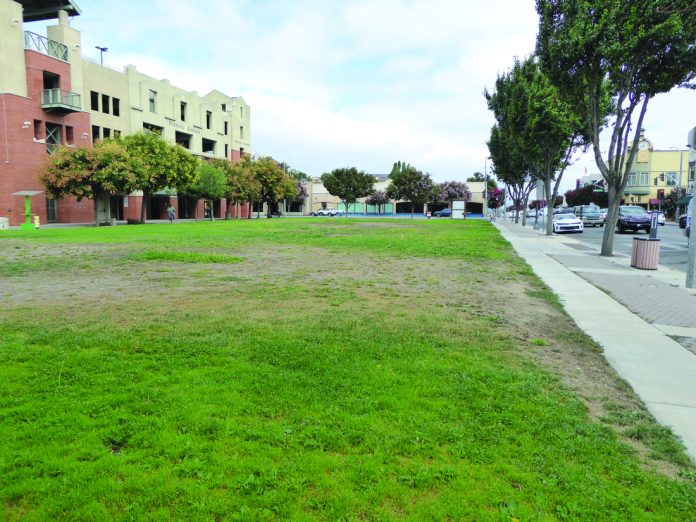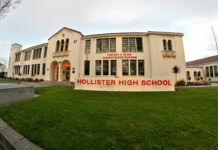The controversial 400 block project will come before the Hollister City Council on Monday, May 20 in what may be the city’s last chance to avoid drawn-out litigation over the site’s future.
Proponents on the council want to move forward with plans to construct 22 condominiums, offices for a non-profit foundation and several ground floor retail spaces while opponents have suggested maintaining an open plaza or building a center for performing arts. Citizens lost the chance to weigh in on the question after the city appealed to state Attorney General Xavier Becerra, who gave the city discretion to sell the land without a public vote.
The effort to develop the currently empty lots at the corner of San Benito and Fourth streets—buildings there were destroyed in the 1989 Loma Prieta Earthquake—has been riddled with complications and public mishaps from the start.
The city tried in 2016 to find a developer to create a mixed-use project in the space, and a local builder, the Del Curto Brothers, along with the Community Foundation of San Benito County proposed a joint project.
That proposed project has generated nearly three years of controversy. The council agreed to a sale price based on an outdated appraisal after city officials withheld a higher appraisal from public view until a public records request by the Free Lance revealed its existence.
A petition drive to have the project appear on the ballot was derailed by the city council, when it sought a ruling by the attorney general on the legality of a referendum. Becerra, after nearly nine months, ruled the decision was an administrative action and therefore was “not subject to a referendum.”
Now Mayor Ignacio Velazquez—who can’t participate in the council decisions because his business, the Vault banquet hall, sits next door to the site—says the city’s 400-block decisions violated several state and local laws .
Velazquez led the 2017 petition drive to seek a referendum on the project, collecting nearly 2,500 signatures. Velazquez now is taking the unusual step of threatening a legal challenge to the project “as a private citizen.”
Two-phase project
The project has two phases. Phase one is the construction of building for the Community Foundation of San Benito County and several non-profit agencies, including the media site it funds, Benitolink. Phase two is a mixed residential/commercial building owned and developed by the Del Curto Brothers of Hollister, with residential units and six ground-floor commercial sites, both of whom would rely on parking in an adjacent structure.
Another marker in the project occurred April 11, when the city planning commission voted 4-1 to approve the Del Curto/Community Foundation project’s subdivision, conditional use permits and tentative map. Velazquez appealed that decision, and his personal lawyers will argue their case in front of the city council May 20.
Velazquez’ appeal is based on his belief that the project violates the California Environmental Quality Act (CEQA), has over the maximum number of allotted residential units and does not qualify for street vacation.
The city first released a request for proposals for the site in 2016 and said its goal was “to sell both parcels to a private developer and construct a new keystone commercial or mixed/use development as a catalyst for economic development in downtown Hollister.”
The low appraisal
The request for proposals took the unusual step of listing an appraised price for the three lots, at $390,000, or $20 per square foot, setting a baseline price for the project. This was based on a 2015 appraisal. In January 2016 the Del Curto Brothers submitted a project proposal to the council. An update of the appraisal was then conducted September 2016 by the same company, Steve Loos Appraisal, and concluded that the property value had doubled—to $690,000.
Loos wrote in a letter of transmittal to Hollister’s development services department: “There has been a significant change in the local market since October 2015,” wrote Loos. “The downtown area continues to adapt to new and changing market conditions, market activity for commercial land and buildings has increased significantly and residential building and home sales continue at a brisk pace with rising prices.”
City manager Bill Avera, told the Free Lance in late 2017 that the council “probably” did not see the new appraisal before the council approved the sale. No council members, including the mayor, could remember seeing it. Avera gave no explanation for failing to share the new information.
The council approved the parcel’s sale for $390,000, based on the 2015 appraisal. The disposition agreement for the project was received June 5, 2017, several months after the new appraisal.
Project manager Mary Paxton said the updated appraisal was done to make sure the value of the property hadn’t dropped, because the city could not sell the property for more than it was worth but could sell it for less. Paxton told the Free Lance that the original appraisal price was kept for Del Curto Brothers because the developer submitted its proposal and designed the project based on the plan.
“They made a proposal based on that value,” said Paxton. “They made a good-faith effort.”
The petition drive
The debate surrounding the project continued beyond the initial proposal’s approval. Velazquez spearheaded a petition to put the 400-block decision to the city’s residents for a vote. The petition received 2,465 signatures, but the city council majority challenged it and, with the help of state assemblywoman Anna Caballero, requested the attorney general’s opinion to confirm its decision without an election. Nine months later, Beccera wrote in an 11-page letter that the “resolution was not subject to a referendum ” stating the council decision was simply an administrative action as part of a redevelopment plan and therefore not required to go before the public.
The 400 block had six businesses prior to the 1989 earthquake, but they moved or closed because of damage to the building. The land had been the responsibility of Hollister’s redevelopment agency since 1995, but in 2011 the state dissolved redevelopment agencies as part of the state budget.
Past attempts to unload the 400 block on developers were unsuccessful. The city’s property management plans said the grassy patch in the middle of Hollister’s downtown was almost a theater/restaurant/retail/office space, a hotel, a performing arts center and another hotel.
After the dissolution of the redevelopment agency, the city could have sold the property or bought it themselves using reserve funds, Paxton said. In 2014, Hollister entered into a compensation agreement with the city’s taxing entities: the Hollister School District, the San Benito County Office of Education, the Gavilan Joint Community College District, the San Benito High School District, the San Benito County Healthcare District and the San Benito County Water District. These entities will split the sale proceeds once the deal is final. The city will only retain 11 percent of the money received from the sale. Each agency will get less money if the sale occurs at the lower value.
The payments
In Phase one of the project, the Community Foundation will pay $141,316. In Phase two, the Del Curto Brothers will pay $248,684. Paxton told the Free Lance the payment will be received when each phase has submitted a building proposal. She said this measure was a way of protecting the city from another lost project. “It’s saying we’re not going to give you the property till we’re sure they’re going to perform,” said Paxton.
Before the money changes hands, the city is still able to use the 400 block for the non-profit activities that have taken place.
The idea of a mixed commercial and residential use for the site dates back to when the redevelopment agency first took over the property. Even when subsequent deals fell through, the city’s general plan called for projects with residential and commercial uses to be built downtown.
The city’s 2016 request for proposals explicitly called for a mixed-use building to be set in the downtown. The Del Curto Brother’s rustic adobe three-story design is in line with the city’s 2009 downown strategy.
City planner Abraham Prado told the Free Lance that the city’s plans call for buildings in the historic downtown to have an “old town” feel. The height limit downtown is 75 feet; the mixed-use building and community foundation offices will stand at 45 feet.
The development will have commercial/retail space on its ground floor, and two floors of one-bedroom and studio apartments. Altogether there will be 22 units, two of which will be designated as “low income” and two others as “very low income.”
With downtown zoning, the lot would have only allowed 18 units to be built, but a density bonus was approved by the planning commission on the contingency that the additional four units be below market rate.
At the May 13 special city council meeting the council, without Velazquez, unanimously voted in closed session to appoint Lauren Layne from the law firm Baker, Manock and Jensen as legal counsel for the appeal.










